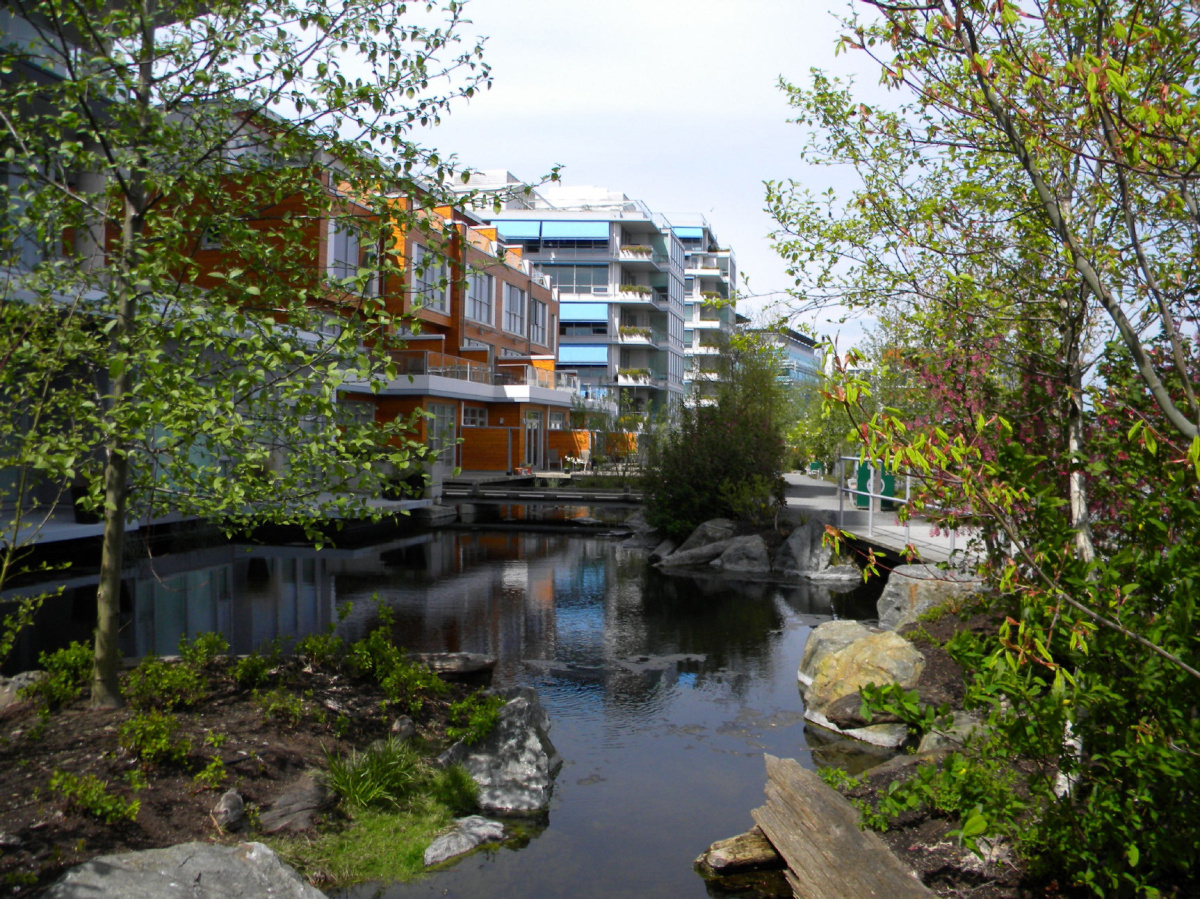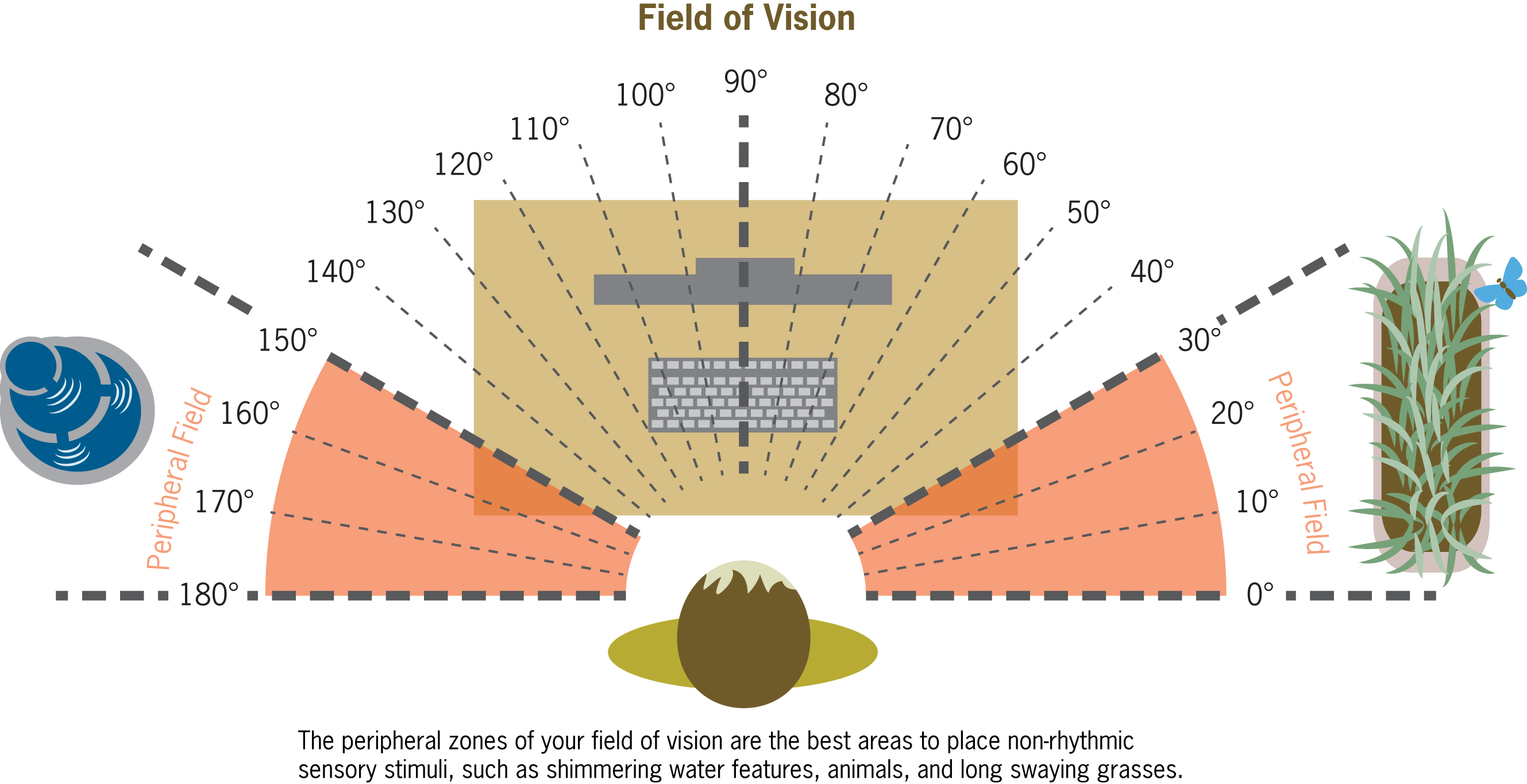This is the third post in an on-going series outlining each of the 14 patterns of biophilic design, a collection of biophilic strategies codified in Terrapin Bright Green’s “14 Patterns of Biophilic Design” paper.
Pattern 3: Non-Rhythmic Sensory Stimuli
Nature is never static; it’s always moving, growing, adapting. We notice when a room is visually monotonous, when the air is stale, and when the same sound, or lack thereof, persists beyond what’s pleasant. How often do you find yourself, or your children staring at televisions and computer screens for hours on end? We are not static beings, yet the spaces we live, study and work in are too often just that – static and predictable.

Dockside Green, © Ellen Moorhouse, Toronto Star
Non-Rhythmic Sensory Stimuli are stochastic and ephemeral connections with nature that can reduce stress and improve productivity.
My use of the word “stochastic” is very deliberate. Often shrugged off as being more of a pesky SAT word than a practical descriptor, it is in fact the most accurate term to describe this pattern — a sensory stimulus that has “a random probability distribution that may be analyzed statistically but may not be predicted precisely”. We can look to science to uncover why this quality of an experience is so important to visual comfort and productivity.
Keeping focus with visual comfort
Studies of the human response to stochastic movement of objects in nature and momentary exposure to natural sounds and scents have shown to support physiological restoration.
Evidence shows the positive impact of non-rhythmic sensory stimuli on occupant heart rate, systolic blood pressure and sympathetic nervous system activity (Li, 2010; Park et al, 2009; Kahn et al., 2008; Ulrich et al., 1991), but it is the relationship between ocular stress and eye lens focal relaxation patterns that is perhaps the most intriguing and logical reason to incorporate non-rhythmic sensory stimuli into architectural design and the user experience (Lewis, 2012; Vessel, 2012).
The 20x20x20 rule
For instance, when sitting and staring at a computer screen, as so many of us do for hours on end, or any other task with a short visual focus (often less than 3 feet), the eye’s lenses become rounded with the contracting of the eye muscles.
After about 20 minutes, eye muscles begin to fatigue and the lenses must harden to maintain that shallow depth of focus. Eye strain, headaches and physical discomfort can result. As we have a habit of staring at our computer screens for much longer durations than 20 minutes, our ability to stay on task becomes depleted, as does our productivity.
The average person may not notice this is happening, they may blink or rub their eyes to refocus, and it may take a few minutes or longer to regain correct focus. If we allow ourselves, either deliberately or by chance, to look away from the computer every 20 minutes or so, fatiguing of the eye muscles and hardening of the lenses can be avoided.
These measurements of distance and duration can serve as a general guideline for incorporating non-rhythmic sensory stimuli into the built environment. I find it easy to remember as the “20x20x20 rule”, whereby sensory experiences are designed to shift our focus approximately every 20 minutes for about 20 seconds at a time and, for visual stimuli, from a distance of more than 20 feet away.
Looking Behavior & Visual Perception
When immersed in nature, we continually experience instances of non-rhythmic stimuli: birds chirping, leaves rustling, the faint scent of eucalyptus in the air. Studies in looking behavior and visual perception show that the brain processes the movement of living things in a different place than it does of mechanical objects (e.g., Beauchamp et al., 2003).
Natural movement is generally perceived as positive, and mechanical movement as neutral or even negative. As a result, the predictable rhythmic motion of a pendulum will only hold one’s attention briefly, the invariable ticking of a clock may come to be ignored over time, and an ever-present scent may lose its mystique with long-term exposure; whereas, seasonal scented plantings or the stochastic movement of a butterfly will capture one’s attention each time for recurring physiological benefits.
However, simulated interventions delivered by way of mechanical systems should not be confused with mechanical objects that are predictable or robotic in character. Simultaneously, while we focus not surprisingly on visual stimuli, non-visual stimuli can also help prevent low-level physiological stresses when the stimuli encourage us to periodically and momentarily adjust visual focal lengths. Mechanically delivered breezes and electronic streaming of natural sounds, for example, can be very effective stimuli.
We also perceive movement in the peripheral view much quicker than straight ahead, which, from a conceptual and space planning perspective, allows great flexibility in design interventions. Passersby can be perceived as a distraction when proximity is immediate, but from 20 feet away and in the periphery, is less likely to engage in discourse but is still close enough to provide periodic visual breaks.
Non-Rhythmic Sensory Stimuli in design
A space with good Non-Rhythmic Sensory Stimuli is fresh, interesting and energizing. It evolves organically as a brief but welcome distraction.
While a biophilic intervention that leverages naturally occurring stimuli may necessitate collaboration with the interior designer or the horticulturist, one that leverages simulated stimuli will likely necessitate early collaboration with the mechanical engineer or facilities team. In either case, it need not be a complex endeavor.

The peripheral zones of your field of vision are the best areas to place non-rhythmic sensory stimuli, such as shimmering water features, animals and long swaying grass.
The important factor is to continuously reassess opportunities with each iteration of a design. Whether its a interior refresh or new construction, it is the iterations that improve the adaptability of a space to its place, for to feel alive and be engaging enough to mitigate potential for low-level stress in a way that improves our ability to concentrate and be more productive, yet happier people.
References
- Beauchamp, M.S., K.E. Lee, J.V. Haxby, & A. Martin (2003). FMRI Responses To Video and Point-Light Displays of Moving Humans and Manipulable Objects. Journal of Cognitive Neuroscience, 15 (7), 991-1001.
- Kahn, Jr. P.H., B. Friedman, B. Gill, J. Hagman, R.L. Severson, N.G. Freier, E.N. Feldman, S. Carrere, & A. Stolyar (2008). A Plasma Display Window? The Shifting Baseline Problem in a Technology Mediated Natural World. Journal of Environmental Psychology, 28 (1), 192-199.
- Lewis, Alan Laird (2012). The New England College of Optometry. Personal communication with the authors.
- Li, Q. (2010). Effect of Forest Bathing Trips on Human Immune Function. Environmental Health and Preventive Medicine, 15 (1), 9-17.
- Park, B.J., Y. Tsunetsugu, T. Kasetani, T. Morikawa, T. Kagawa, & Y. Miyazaki (2009). Physiological Effects of Forest Recreation in a Young Conifer Forest in Hinokage Town, Japan. Silva Fennica, 43 (2), 291-301.
- Ulrich, R. S., Simons, R., Losito, B. D., Fiorito, E., Miles, M. A., & Zelson, M. (1991). Stress recovery during exposure to natural and urban environments. Journal of Environmental Psychology, 11, 201–230.
- Vessel, Edward A. (2012). New York University Center for Brain Imaging. Personal communication with the authors.